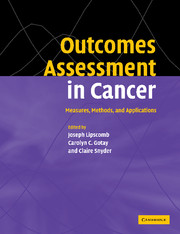Book contents
- Frontmatter
- Contents
- List of contributors
- Acknowledgments
- 1 Introduction to Outcomes Assessment in Cancer
- Health-related quality of life in cancer: general concepts and generic measures
- Assessing health-related quality of life during treatment
- Assessing health-related quality of life across the cancer continuum
- Measuring the experience and needs of cancer patients and caregivers
- 13 Patient advocate perspective on health-related quality of life issues with prostate cancer survivors
- 14 Measuring the patient's perspective on the interpersonal aspects of cancer care
- 15 Needs assessment in cancer
- 16 Assessing the subjective impact of caregiving on informal caregivers of cancer patients
- Methodological considerations in applications to cancer outcomes research
- Modern psychometric theory in cancer outcomes research
- Assessing the economic impact of cancer
- Research and policy implications
- Invited papers
- Index
- References
14 - Measuring the patient's perspective on the interpersonal aspects of cancer care
Published online by Cambridge University Press: 18 December 2009
- Frontmatter
- Contents
- List of contributors
- Acknowledgments
- 1 Introduction to Outcomes Assessment in Cancer
- Health-related quality of life in cancer: general concepts and generic measures
- Assessing health-related quality of life during treatment
- Assessing health-related quality of life across the cancer continuum
- Measuring the experience and needs of cancer patients and caregivers
- 13 Patient advocate perspective on health-related quality of life issues with prostate cancer survivors
- 14 Measuring the patient's perspective on the interpersonal aspects of cancer care
- 15 Needs assessment in cancer
- 16 Assessing the subjective impact of caregiving on informal caregivers of cancer patients
- Methodological considerations in applications to cancer outcomes research
- Modern psychometric theory in cancer outcomes research
- Assessing the economic impact of cancer
- Research and policy implications
- Invited papers
- Index
- References
Summary
Introduction
This chapter provides a critical review of the literature on patient reports and evaluations of interpersonal aspects of cancer care as indicators of the quality of cancer care, which we will call “the patient's perspective.” The rationale for placing the patient at the center of efforts to assess the quality of health care is well established: policy makers, health care providers, purchasers of care, and researchers are interested in what patients think. For example, the National Health Care Quality Report, to be published in 2003, will include the consumer's perspective as a key indicator of health care quality.
Donabedian stated that “achieving and producing health and satisfaction, as defined for its individual members by a particular society or subculture is the ultimate validator of the quality of care.” He saw that the patient's greatest contribution to measuring health care quality is assessing the interpersonal aspects of care.
The specific justifications for the interest in the patient's perspective have changed somewhat over time. Originally, they were based on evidence that patients who are satisfied are more likely to comply with treatment regimens, provide relevant information to the health care provider, and return for care.– Thus, measuring the patient's perspective, particularly satisfaction, may be important to the health care provider from the standpoint of keeping the patient as a customer, because satisfied patients are more likely to stay with their doctors. Patients who changed doctors say that the doctor's style and personality were the main reasons.
- Type
- Chapter
- Information
- Outcomes Assessment in CancerMeasures, Methods and Applications, pp. 290 - 304Publisher: Cambridge University PressPrint publication year: 2004
References
- 5
- Cited by



